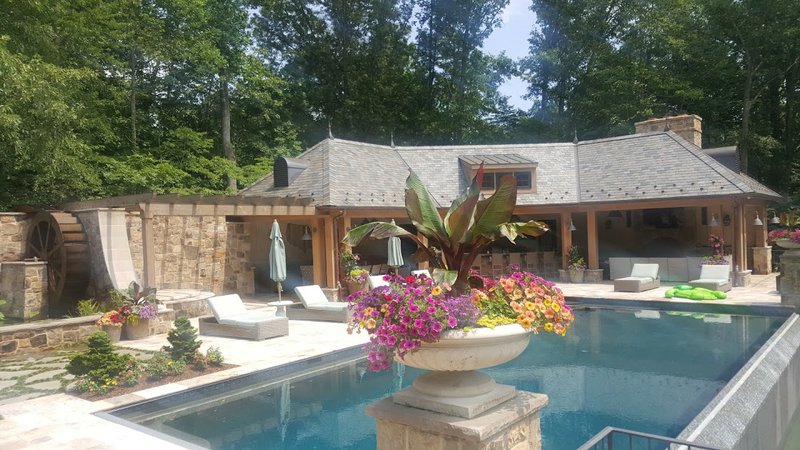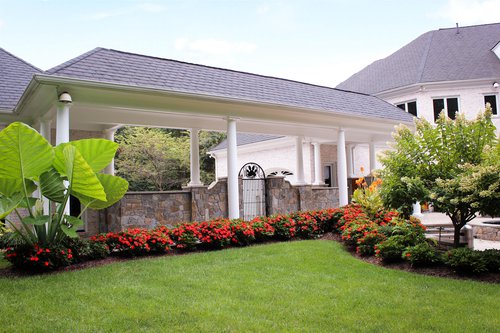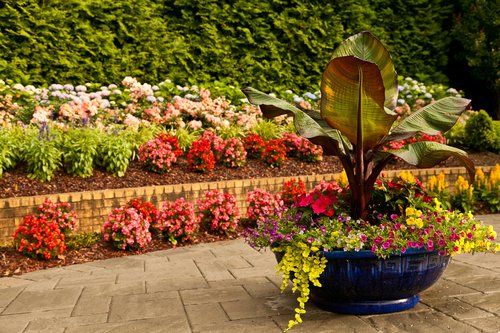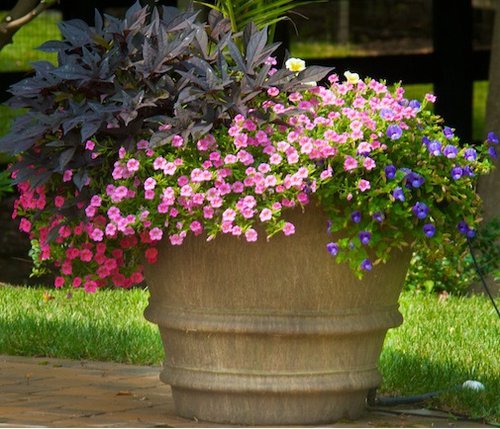
Accenting with Annuals
Add bursts of color and texture to enhance your landscape by planting annual flowers.
Once the cold is gone for good and the last frost has hit, it’s time to add a bit of color to your landscape. In our region, May is the month for planting annual flowers. The yearly yard prep helps to ready your property for outdoor entertaining season — bringing elegance, variety and a welcoming setting for you and your guests.
Think of it as living decor. Your outdoor spaces should show your personality the same way your indoor spaces do — carefully selected and arranged to suit a theme or vibe that fits your style. Working with a professional landscaping company can help you design and curate floral displays that bring your vision to life.
Spicing Up a Space

One of the most effective ways to use flowers to liven up a landscape is to add color to an otherwise lackluster area. Evergreen corners of the yard, walking paths and entryways, or greenery-lined walls can all benefit from a few pops of color and texture.
In particular, curb appeal can be greatly enhanced with a bit of creativity. Front yard beds are ideal for framing your home with a sense of style and character, and your front walk and entryway are the first impressions your visitors have when arriving. A floral-lined walk-up path ending in porch pots overflowing with show-stopping displays flanking the door can be an inviting way to greet your guests.
Container gardens are excellent visuals, whether in a hanging basket, a floor pot or a window box. All can be used effectively to brighten your home’s exterior.
Container plantings are also a popular way to soften backyard hardscapes and entertainment spaces while adding a bit of charm. In spaces where there is an expanse of patio or deck, trough planters can be used as an above-ground planting bed with a fully designed garden. Add a few pots and planters in various sizes to create variety and elevation change on a flat surface like patios, decks, and rooftops.
Planting Annual Flowers Successfully

As you think through the many ways to enhance your property by planting annual flowers, keep in mind that planning out a little in advance can go a long way toward a healthy, cohesive landscape.
When considering where to put an in-ground flower garden, think about how much sun the area gets, what kind of soil is present, or if it’s an area where a lot of wildlife can make trouble. Is it a high-traffic area, or a place where children will be running around?
All of these factors play into the type of plants to choose and what kind of arrangement will work. With these criteria and a few color preferences or specific plants, a professional landscaper can help create a masterpiece that will thrive in any area of the yard.
When envisioning your container gardens and annual planters, try to go with the “thriller, filler, spiller” mantra: a large, eye-catching centerpiece (thriller), lots of color in the middle (filler), and trailing plants that drape over the sides (spiller). Play around with the idea of using varying textures and complementary colors.
Popular statement centerpieces include mandevilla, hibiscus or giant ferns. Surround your focal point with mid-height plants that will grow about a foot high to fill out the display’s center. Lantana is drought resistant, heavy-blooming, and they don’t require a lot of maintenance. Coleus and New Guinea impatiens are also common fillers.
The final touch is the cascading spiller plants over the edge of the containers. Bacopa, ivy, and superbell petunias are popular choices. Though it carries a reputation as an invasive ground plant, Creeping Jenny is perfect as a container addition with its waterfall of coin-shaped leaves that contrast a container display beautifully.
If you have areas of your yard that you’d like to remain private or enclosed, screener plants like tall trees or vines on trellises can make for a beautiful way to create seclusion. These can even be placed along decks and patios. Add flowers overflowing the edge of the planters and between the screener plants for a boost of color. Lantana is drought resistant, heavy-blooming, and they don’t require a lot of maintenance. Coleus and New Guinea impatiens are also common fillers.
Remember, annual plants aren’t permanent. Annual displays are flexible in that they can be rearranged, switched up or enhanced based on changing trends or visions. You can even theme gardens based on holidays or seasons. Annual gardening is only as limited as your imagination.
Partnering with a Pro

Finding the right landscaper to help bring your property to bloom in all its glory can make the experience fun and hassle-free while ensuring extremely high-quality, professional-level design and maintenance. Experience and attention to detail make the difference when choosing a landscaper.
You’ll want to look for a company that has your long-term vision in mind, and will design, plant and maintain to bring it to fruition. They should have a strong reputation for perfection and quality, and offer the services you need from start to finish and beyond.
Rossen Landscape, for example, starts planting programs before putting flowers in the ground. Each year at the start of spring, we prep both container and ground soil to make sure it’s rich, fluffy, well-drained and ready for plants to thrive. We then work closely with clients to design the perfect outdoor spaces. As the season continues, we offer a flower care program where we come to the property every three weeks to apply liquid fertilizer, train vines, trim, prune and pinch plants to keep them in optimal condition and shape. At the end of the season, around mid-October or early November, we will replace the annual flowers with cooler-weather plants like pansies.
To talk through your ideas with our team of experts, contact us today.





